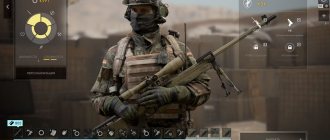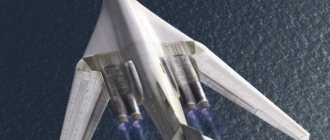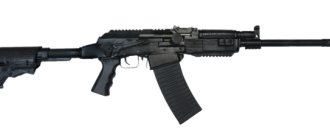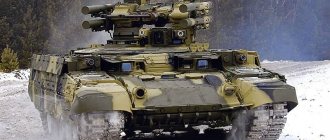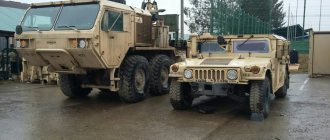PBRK "Bastion" for the Black Sea Fleet
• At the beginning of 2011, the Black Sea Fleet, namely the 11th separate coastal missile and artillery brigade (dislocation - Anapa) received the third mobile coastal missile system (PBRK) "Bastion" . The two previous complexes (batteries) were delivered in 2010. The 11th brigade is armed with old but powerful weapons - self-propelled 130-mm gun mounts A-222 "Bereg" and anti-ship missile system "Redut".
• The Bastion complex began to be developed back in the Soviet Union in the 80s, but only now began to be put into service and offered for export (Vietnam and Syria bought several complexes, Venezuela is considering the possibility of purchase). This is a very powerful weapon, one of the best in its class, the mobile missile system is armed with a supersonic anti-ship missile (ASM) of the 3M55 “Yakhont” (“Onyx”) series.
• The Bastion mobile coastal missile system is capable of hitting surface ships and vessels of all classes and types, both single targets and landing, aircraft carrier, strike groups, and in conditions of fire and electronic countermeasures. The Bastion PBRK is capable of hitting targets at a distance of up to 300 km , and covering a 600 km from enemy landing operations.
•
Composition of the Bastion complex : - K-310 Yakhont anti-ship missiles in a transport and launch container; — Self-propelled launchers (SPU K340P) on the KamAZ-43101 chassis (crew of 5 people) or MZKT-7930 (crew of 3 people); — Combat control vehicle (MBU K380P) on the MZKT-65273 chassis (crew 4 people); — Equipment for information and technical interface of PBRK combat assets with the main command post; — Automated combat control system (ASBU) PBRK; — Set of technical maintenance equipment (KSTO); — Transport-loading vehicles (TZM K342P); — Combat duty support vehicles (MOBD); — Educational and training complex (UTC); — Helicopter target designation complex (VTC).
• The standard Bastion battery consists of : - 4 self-propelled launchers with two transport and launch tubes for Yakhont missiles (crew 3 people); — 1-2 combat control vehicles (crew 5 people); — 1 combat duty support vehicle (MOBD); — 4 transport-charging vehicles. • Additionally, the Bastion PBRK can be reinforced with the Monolit B self-propelled over-the-horizon radar for detecting surface and air targets and target designation.
• The combat readiness time of the complex is 5 minutes , after which the complex can fire with 8 missiles. — Maximum ammunition of the complex: 24 anti-ship missiles "Yakhont" (12 launchers for 2 anti-ship missiles). — The launch interval of Yakhont missiles during salvo firing from one launcher is 2.5 s. — After deployment, the battery can maintain autonomous combat duty without auxiliary equipment - 24 hours (30 days with MOBD). — The designated service life of the complex is 10 years.
"Collective mind"
“Onyx” is not just a high-precision intelligent weapon operating on the “fire and forget” principle. These missiles also have a “collective intelligence.” They are most effective when launched in salvo. In flight, the Onyxes exchange information with each other and, based on an analysis of the composition of the ship group, distribute targets among themselves according to the principle, draw up an attack plan and tactics for its implementation. Some missiles can attack a target head-on, others can covertly fly around the ship and enter from the rear, and the approach time is selected so that an attack by several missiles is carried out simultaneously.
All that remains is to quote one more quote from Vladimir Putin from the film about Crimea: “No one has such weapons.”
New Russian missile developments
Nowadays, the Russian army is being rearmed with new missiles:
- RS-24 "Yars", which are gradually replacing the RS-18 and RS-20 ICBMs (as their service life expires);
- RS-26 "Rubezh" - high-precision ICBM;
- RS-28 Sarmat is a heavy ICBM that effectively bypasses American missile defense systems, especially due to launches through the South Pole;
- X-50 - a new operational-tactical air-to-ground missile, virtually invisible to air defense systems;
- S-500 "Prometheus" is the latest air defense and missile defense missile system.
The newest Zircon-S missile launcher with a next-generation strategic hypersonic missile is also being developed.
Organization of the coastal defense complex
“Bastion” is a coastal missile system, which includes:
Yakhont missiles contain advanced innovations, such as:
- over-the-horizon target engagement distance;
- complete independence of combat use (“fire and forget”);
- independent adjustment of selective (“low”, “high + low”) trajectories;
- highest speeds (supersonic) in all flight zones;
- complete standardization for a wide range of media of potential threats;
- low visibility for detection by the enemy using all modern radars.
Yakhont anti-ship missiles are made according to a standard aerodynamic layout - a trapezoidal folding wing and tail. The aerodynamics of the rocket, combined with the highest thrust-to-weight ratio, guarantees Yakhont maneuverability. This allows the Yakhont, which is equipped with the Bastion (missile system), to successfully perform evasion maneuvers from enemy weapons.
Strictly speaking, “Yakhont” is a symbiosis of an airframe and a power plant. The difference is presented in the form of a central air intake cone. It is in it that the guidance system units with the radar antenna and, in fact, the warhead are located. The rest of the part is occupied by the main engine, the fuel tank and, in fact, the accelerating stage, which runs on solid fuel.
“Bastion” is a missile system, the characteristics of which have been significantly improved by newly developed missiles.
Purpose[edit | edit code]
Designed to destroy surface ships of various classes and types from amphibious formations, convoys, ship and aircraft carrier strike groups, as well as single ships and ground radio-contrast targets in conditions of intense fire and electronic countermeasures.
The Bastion ballistic missile launcher is one of the carriers of the Onyx missile, which, in turn, along with the Caliber and Kh-35 Uran missile systems and the promising Zircon hypersonic anti-ship missile, is the main anti-ship missile weapon in the Armed Forces Russia.
Main tasks
The fifth generation missile system S-500 performs three main tasks:
- Security;
- Interception;
- Liquidation.
The complex copes with all these tasks perfectly. S-500 has unique characteristics:
- It is protected from guidance and radio detection systems, as well as from any system that creates various types of interference for the missile and its targeting. As a result, the enemy will not be able to evade interception and liquidation. This is a special pride of the developers;
- The interception of any flying objects is ensured at a distance of up to 3,500 km and at a maximum altitude of up to 50 km. For comparison: the vaunted American “Patriot” is capable of “reaching” a high-flying object only up to 24 km;
- Ensures the elimination of the most modern means of air combat. Russian developers have achieved incredible results. The S-500 air defense system can easily combat low-orbit satellites, orbital platforms, hypersonic cruise missiles, aircraft and drones.
Notes[edit | edit code]
- Tikhonov, T.1, 2010, p. 174.
- Mobile coastal missile system "Bastion" with anti-ship missiles "Yakhont"
- Stationary Coastal Missile Complex Bastion
- Vietnam received the K-300P Bastion-P PBRK, TsAMTO, 06/30/2010
- New weapons of the Navy will be shown at the Victory Parade in Rostov. 22.4.2014
- A dress rehearsal for the Victory Parade took place in Sevastopol. 6.5.2014
- RIA News.
Russian Black Sea Fleet forces destroyed a training target at a distance of 90 km
(unspecified)
(09.09.2014). - Putin: we wanted the Bastion complexes in Crimea to be visible from space (unspecified)
.
gazeta.ru
(03/15/2015). - Crimean "Bastions". Five advantages of the Bastion missile system Archived copy dated October 25, 2020 on the Wayback Machine, Leonid Sitnik. Article on the website vtbrussia.ru
, 09/17/2015 - Russian Ministry of Defense.
Kalibr and Onyx cruise missiles engage terrorists' objects in Syria
(unspecified)
(November 15, 2016). Retrieved November 15, 2020. - Video: Missiles of the Bastion coastal complex hit targets in Syria, 11/16/2016, Nikolay Grishchenko, “Russian weapons” (FGBU “Editing Office of the Rossiyskaya Gazeta”).
- Anti-ship "Bastion" was taught to fire on land - Izvestia
- The Military Balance 2020, p. 201
- “Bastion” and “Yakhont” - not only Syria, Periscope2.ru, 09.20.2009
- The third Bastion PBRK was transferred to the Russian Black Sea Fleet TsAMTO
- New “Bastions” were transferred to Crimea instead of those transferred to Syria (unspecified)
. Lenta.ru. Retrieved November 30, 2020. - Russia has deployed coastal missile systems “Bal” and “Bastion” (unspecified)
. Interfax. Retrieved November 22, 2020. - “Bastions” in Kamchatka will protect the strategic “Boreas” (undefined)
. Izvestia newspaper (02/22/2017). Retrieved February 22, 2017. - The source reported the deployment of Bastion complexes in the Kaliningrad region (unspecified)
. Lenta.ru. Retrieved November 21, 2020. - The fleet will receive five Bastion missile systems in 2016
- The Navy planned to deploy the first Bastion missile system in Crimea by 2020
- Russia will deploy the Bastion coastal complex in the Kuril Islands (unspecified)
. Lenta.ru. Retrieved November 22, 2020. - The Russian Navy received three divisions of Bastion complexes in 2019
- Russia supplied Vietnam with the second Bastion anti-tank missile system TsAMTO
- Russia supplied Syria with Bastion anti-ship systems Lenta.ru
- BBC News - Syria crisis: US rues Russian missiles sent to Damascus
- “Bastion”: a reliable guardian of the sea coast, August 25, 2015
Supersonic speed
The maximum speed of Onyx is 2.6 times the speed of sound (750 m/s). This, firstly, makes it extremely difficult to intercept a missile by air defense systems due to the short flight time, and secondly, it reduces the requirements for the accuracy of the external target designation system. The ship simply does not have time to sail far in the few minutes that the rocket is in the air.
A ramjet engine (ramjet) allows Onyx to achieve such high speeds. Unlike a conventional turbojet engine, it has no rotating parts - a turbine and a compressor, which ensures high reliability and efficiency at high speeds. It is precisely this engine that will be used on promising hypersonic missiles, which are currently being developed by NPO Mashinostroyeniye.
The main danger is surprise
Historical experience teaches that a serious armed conflict, as a rule, begins with a massive air strike. Nowadays, this concept includes the actions of attack and bomber aircraft in conjunction with missile fire at facilities vital for defense (control systems, communications, power supply, places where manpower and equipment are concentrated, industrial and transport hubs). The suddenness of the strike, if successful, leads to the fact that the air defense system ceases to operate, and as a result, the potential of the attacked country (both economic and military) is destroyed. The S-300 complex is capable of quickly responding to emerging threats thanks to the high speed of detection and guidance systems, leveling the factor of surprise. 48N6, the missile that forms the basis of the system's firepower, has unique flight characteristics and high charge power.
Manufacturer of the Bal-E complex
The Kaluga Typhoon plant manufactured the complexes in July 2004, and the readiness of the system for testing was checked there.
For two and a half months from July 2004, State tests of the “Bal” equipped with Kh-35E missiles were carried out. The developer of the product is the Tactical Missile Weapons Corporation association.
During the tests, all missiles hit the specified targets.
These tests were recognized as successful by the state commission in October 2004. And by 2088, the complex was put into service.
The first complexes entered service with the coastal missile division (formed in 2011) of the Caspian Flotilla.
To gain skills in managing the Bal-E coastal complex, special courses were organized at the manufacturer. For this purpose, a group was formed from combat officers of the coastal missile unit of the CFL.
